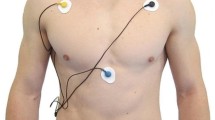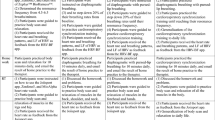Abstract
This article celebrates the contributors who inspired Truman’s heart rate variability (HRV) research program. These seminal influences include Robert Fried, Richard Gevirtz, Paul Lehrer, Erik Peper, and Evgeny Vaschillo. The Truman State University Applied Psychophysiology Laboratory’s HRV research has spanned five arcs: interventions to teach diaphragmatic breathing, adjunctive procedures to increase HRV, HRV biofeedback (HRVB) training studies, the concurrent validity of ultra-short-term HRV measurements, and rhythmical skeletal muscle tension strategies to increase HRV. We have conducted randomized controlled trials, primarily using within-subjects and mixed designs. These studies have produced eight findings that could benefit HRVB training. Effortful diaphragmatic breathing can lower end-tidal CO2 through larger tidal volumes. A 1:2 inhalation-to-exhalation (I/E) ratio does not increase HRV compared to a 1:1 I/E ratio. Chanting “om,” listening to the Norman Cousins relaxation exercise, and singing a fundamental note are promising exercises to increase HRV. Heartfelt emotion activation does not increase HRV, enhance the effects of resonance frequency breathing, “immunize” HRV against a math stressor, or speed HRV recovery following a math stressor. Resonance frequency assessment achieved moderate (r = 0.73) 2-week test-reliability. Four weeks of HRVB training increased HRV and temperature, and decreased skin conductance level compared with temperature biofeedback training. Concurrent-validity assessment of ultra-short-term HRV measurements should utilize rigorous Pearson r and limits of agreement criteria. Finally, rhythmical skeletal muscle tension can increase HRV at rates of 1-, 3-, and 6-cpm. We describe representative studies, their findings, significance, and limitations in each arc. Finally, we summarize some of the most interesting unanswered questions to enable future investigators to build on our work.
Similar content being viewed by others
References
Bax, A., Robinson, T., Goedde, J., & Shaffer, F. (2007). The Cousins relaxation exercise increases heart rate variability [Abstract]. Applied Psychophysiology and Biofeedback, 32, 52–72. https://doi.org/10.1007/s10484-007-9032-z
Charlesworth, E. A., & Nathan, R. G. (2004). Stress management: A comprehensive guide to wellness. Ballantine Books.
Fisher, L. R., & Lehrer, P. M. (2022). A method for more accurate determination of resonance frequency of the cardiovascular system, and evaluation of a program to perform it. Applied Psychophysiology and Biofeedback, 47, 17–26. https://doi.org/10.1007/s10484-021-09524-0
Fleming, T. R., & DeMets, D. L. (1996). Surrogate end points in clinical trials: Are we being misled? Annals of Internal Medicine, 125, 605–613. https://doi.org/10.7326/0003-4819-125-7-199610010-00011
Fuller, J., Wally, C., Carrell, D., Peterson, J., Ward, A., Westermann-Long, A., Korenfeld, D., Burklund, Z., Shepherd, S., Jones, D., Francisco, A., Kane, A., Zerr, C., & Shaffer, F. (2012a). Can ujjayi breathing increase the effectiveness of 6-bpm heart rate variability training [Abstract]? Applied Psychophysiology and Biofeedback, 37, 297–298. https://doi.org/10.1007/s10484-012-9206-1
Fuller, J., Wally, C., Carrell, D., Peterson, J., Ward, A., Westermann-Long, A., Korenfeld, D., Burklund, Z., Shepherd, S., Jones, D., Francisco, A., Kane, A., Zerr, C., & Shaffer, F. (2012b). Does heartfelt emotion increase heart rate variability? [Abstract]. Applied Psychophysiology and Biofeedback, 37, 301. https://doi.org/10.1007/s10484-012-9206-1
Fuller, J., Wally, C., Carrell, D., Peterson, J., Ward, A., Westermann-Long, A., Korenfeld, D., Burklund, Z., Shepherd, S., Jones, D., Francisco, A., Kane, A., Zerr, C., & Shaffer, F. (2012c). Does adding heartfelt emotion to resonance frequency breathing increase heart rate variability? [Abstract]. Applied Psychophysiology and Biofeedback, 37, 297. https://doi.org/10.1007/s10484-012-9206-1
Fuller, J., Wally, C., Westermann-Long, A., Korenfeld, D., & Carrell, D. (2011). Resonance frequency measurements are reliable [Abstract]. Applied Psychophysiology and Biofeedback, 36, 219. https://doi.org/10.1007/s10484-011-9168-8
Grant, J., Wally, C., & Truitt, A. (2010). The effects of Kargyraa throat-singing and singing a fundamental note on heart rate variability. BFE 2010 Conference, Rome, Italy
Khazan, I. (2019). Biofeedback and mindfulness in everyday life: Practical solutions for improving your health and performance. W. W. Norton & Company.
Khazan, I., Shaffer, F., Lyle, R., Moss, D., & Rosenthal, S. (in press). Evidence-based practice in biofeedback and neurofeedback (4th ed.). Association for Applied Psychophysiology and Biofeedback
Korenfeld, D., Shepherd, S., Jones, D., Burklund, Z., Kane, A., Zerr, C., Vodopest, T., Spalding, K., Hoffman, W., Allen, J., Bowers, S., McDermott, M., Fuller, J., Peterson, J., Westermann-Long, A., Francisco, A., Fluty, E., & Shaffer, F. (2013a). Can heartfelt emotion facilitate autonomic recovery from a math stressor? [Abstract]. Applied Psychophysiology and Biofeedback, 38, 215. https://doi.org/10.1007/s10484-013-9229-2
Korenfeld, D., Shepherd, S., Jones, D., Burklund, Z., Kane, A., Zerr, C., Vodopest, T., Spalding, K., Hoffman, W., Allen, J., Bowers, S., McDermott, M., Fuller, J., Peterson, J., Westermann-Long, A., Francisco, A., Fluty, E., & Shaffer, F. (2013b). Can heartfelt emotion attenuate the autonomic effects of a math stressor? [Abstract]. Applied Psychophysiology and Biofeedback, 38, 215–216. https://doi.org/10.1007/s10484-013-9229-2
Lehrer, P. M., Vaschillo, E., & Vaschillo, B. (2000). Resonant frequency biofeedback training to increase cardiac variability: Rationale and manual for training. Applied Psychophysiology and Biofeedback, 25(3), 177–191. https://doi.org/10.1023/a:1009554825745
Lehrer, P., Vaschillo, B., Zucker, T., Graves, J., Katsamanis, M., Aviles, M., & Wamboldt, F. (2013). Protocol for heart rate variability biofeedback training. Biofeedback, 41(3), 98–109. https://doi.org/10.5298/1081-5937-41.3.08
Levin, T. C., & Edgerton, M. E. (1999). The throat singers of Tuva. Scientific American, 281(3), 80–87.
Mason, H., Vandoni, M., deBarbieri, G., Codrons, E., Urgargol, V., & Bernardi, L. (2013). Cardiovascular and respiratory effect of yogic slow breathing in the yoga beginner: What is the best approach? Evidence-Based Complementary and Alternative Medicine, 2013, 743504. https://doi.org/10.1155/2013/743504
McCraty, R. (2017). New frontiers in heart rate variability and social coherence research: Techniques, technologies, and implications for improving group dynamics and outcomes. Frontiers in Public Health. https://doi.org/10.3389/fpubh.2017.00267
Meehan, Z., Muesenfechter, N., Gravett, N., Watson, T., Smith, A., Shearman, S., Bartochowski, Z., West, A., & Shaffer, F. (2018). A 1:2 inhalation-to-exhalation ratio does not increase heart rate variability during 6-bpm breathing [Abstract]. Applied Psychophysiology and Biofeedback, 43, 109–111. https://doi.org/10.1007/s10484-018-9390-8
Peper, E., Holt, C. F., & Gibney, K. H. (2002). Make health happen: Training yourself to create wellness (2nd ed.). Kendall Hunt Publishing Company.
Shaffer, F., Bergman, S., & Gannon, L. (1998). Breathing effort depresses end-tidal CO2 [Abstract]. Applied Psychophysiology and Biofeedback, 23, 128. https://doi.org/10.1023/A:1022172522869
Shaffer, F., Mayhew, J. L., Bergman, S., Dougherty, J., & Koester, A. (1999). Effortful breathing may lower end-tidal CO2 through increased tidal volume [Abstract]. Applied Psychophysiology and Biofeedback, 24, 124. https://doi.org/10.1023/A:1022274311231
Shaffer, F., Meehan, Z. M., & Zerr, C. L. (2020). A critical review of ultra-short-term heart rate variability norms research. Frontiers in Neuroscience. https://doi.org/10.3389/fnins.2020.594880
Shaffer, F., Moss, D., & Meehan, Z. M. (2022). Rhythmic skeletal muscle tension increases heart rate variability at 1- and 6 contractions per minute. Applied Psychophysiology and Biofeedback. https://doi.org/10.1007/s10484-022-09541-7
Shearman, S., Meehan, Z., & Shaffer, F. (2018). Ultra-short-term (UST) HRV measurements can achieve strong concurrent validity [Abstract]. Applied Psychophysiology and Biofeedback, 43, 109–111. https://doi.org/10.1007/s10484-018-9390-8
Spielberger, C. D. (1983). State-trait anxiety inventory for adults (STAI-AD) [Database record]. APA PsycTests. https://doi.org/10.1037/t06496-000
Urban, H., Gravett, N., Berlinger, J., & Shaffer, F. (2019a). Limits of agreement (LoA) determination of minimum epochs for estimating 5-min ultra-short-term (UST) heart rate variability measurements. Oral paper presented at the 50th Association for Applied Psychophysiology and Biofeedback Annual Meeting
Urban, H., Gravett, N., Owen, D., & Shaffer, F. (2019b). Confirmation that rhythmical skeletal muscle tension (RSMT) can increase heart rate variability. Oral paper presented at the 50th Association for Applied Psychophysiology and Biofeedback Annual Meeting
Vaschillo, E. (2018). Biofeedback, baroreflex, and cardiovascular system functioning. AAPB 2018 Convention, Orlando
Vaschillo, E., Lehrer, P., Rishe, N., & Konstantinov, M. (2002). Heart rate variability biofeedback as a method for assessing baroreflex function: A preliminary study of resonance in the cardiovascular system. Applied Psychophysiology and Biofeedback, 27, 1–27. https://doi.org/10.1023/a:1014587304314
Vaschillo, E. G., Vaschillo, B., Pandina, R. J., & Bates, M. E. (2011). Resonances in the cardiovascular system caused by rhythmical muscle tension. Psychophysiology, 48, 927–936. https://doi.org/10.1111/j.1469-8986.2010.01156.x
Wally, C., Fuller, J., Carrell, D., Korenfeld, D., & Westermann-Long, A. (2011). Chanting Om increases heart rate variability by slowing respiration [Abstract]. Applied Psychophysiology and Biofeedback, 36, 223. https://doi.org/10.1007/s10484-011-9168-8
Watson, D., & Clark, L. A. (1994). The PANAS-X: Manual for the positive and negative affect schedule-expanded form. University of Iowa
Zerr, C., Kane, A., Vodopest, T., Allen, J., Fluty, E., Gregory, J., DeBold, M., Schultz, D., Robinson, G., Golan, R., Hannan, J., Bowers, S., Cangelosi, A., Korenfeld, D., Jones, D., Shepherd, S., Burklund, Z., Spaulding, K., Hoffman, W., & Shaffer, F. (2014). HRV biofeedback training raises temperature and lowers skin conductance [Abstract]. Applied Psychophysiology and Biofeedback, 39, 299. https://doi.org/10.1007/s10484-014-92549
Zerr, C., Kane, A., Vodopest, T., Allen, J., Hannan, J., Fabbri, M., Williams, C., Cangelosi, A., Owen, D., Cary, B., & Shaffer, F. (2015). Does inhalation-to-exhalation ratio matter in heart rate variability biofeedback? [Abstract]. Applied Psychophysiology and Biofeedback, 40, 135. https://doi.org/10.1007/s10484-015-9282-0
Acknowledgements
We thank the students who participated in this research and the laboratory managers and research assistants who helped collect these data.
Author information
Authors and Affiliations
Corresponding author
Ethics declarations
Conflict of interest
No authors have conflict of interest to report.
Additional information
Publisher's Note
Springer Nature remains neutral with regard to jurisdictional claims in published maps and institutional affiliations.
Rights and permissions
About this article
Cite this article
Shaffer, F., Meehan, Z.M. An Undergraduate Program with Heart: Thirty Years of Truman HRV Research. Appl Psychophysiol Biofeedback 47, 317–326 (2022). https://doi.org/10.1007/s10484-022-09543-5
Accepted:
Published:
Issue Date:
DOI: https://doi.org/10.1007/s10484-022-09543-5




